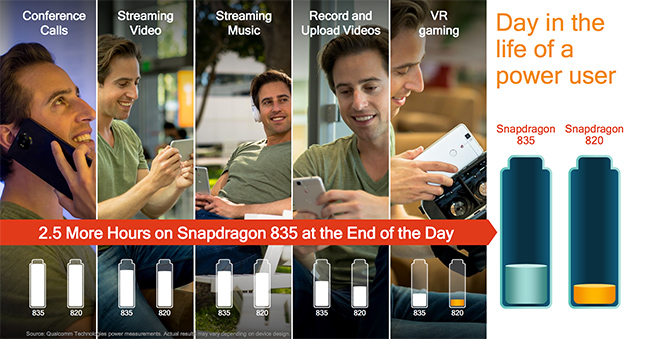The Qualcomm Snapdragon 835 Performance Preview
by Matt Humrick & Ryan Smith on March 22, 2017 4:30 AM EST- Posted in
- Smartphones
- Snapdragon
- Qualcomm
- Mobile
- SoCs
- Snapdragon 835
- Kryo
First Thoughts
Mobile SoCs are packed with specialized processors: CPU, GPU, high-performance DSP (compute), low-power DSP (sensor hub), modem DSP (signal processing), ISP (image processing), fixed-function blocks (video, audio), etc. And while all of these pieces contribute to the overall user experience, some of them are difficult to quantify. The CPU and GPU remain vital to device performance and battery life, so it’s still important to probe their capabilities.
Our initial testing shows that Snapdragon 835’s Kryo 280 CPU is an octa-core, big.LITTLE configuration with four semi-custom A73 “performance” cores and four semi-custom A53 “efficiency” cores. Kryo 280’s performance cores are pretty much equivalent to Kirin 960’s A73 cores in both integer and floating-point IPC, but comparing them to Snapdragon 820’s Kryo CPU shows mixed results: integer IPC improves but floating-point regresses.
In our limited system testing, the Snapdragon 835’s IPC gains outweigh its losses, providing better overall performance than the Snapdragon 820/821 phones. Unsurprisingly, the Snapdragon 835 MDP/S matched the performance of the Mate 9’s Kirin 960, which may not sound all that exciting, but considering our positive experience with the Mate 9, it’s certainly not bad either.
Qualcomm continues to push hard into VR/AR, not just with smartphones but stand-alone HMDs too. The high resolution and low latency requirements for these experiences suddenly make the GPU a bottleneck once again. The Snapdragon 835’s updated Adreno 540 GPU, through a combination of microarchitecture tweaks and a higher peak operating frequency, is another evolutionary step along the VR path, delivering a 25% peak performance boost over Snapdragon 820’s Adreno 530.
As noted earlier, all of these results came from pre-production hardware and software that’s under Qualcomm’s control, so performance could still go up or down once retail units begin shipping; however, based on these preliminary numbers and feature additions, the Snapdragon 835 looks like a solid evolutionary upgrade over the S820. The one glaring omission in this initial assessment, though, is power efficiency, which is critical to both battery life and sustained performance. The potential power savings from the move to 10nm and the CPU swap could have a larger impact on user experience than the small performance gains and new features.













128 Comments
View All Comments
Andrei Frumusanu - Wednesday, March 22, 2017 - link
What a load of nonsense. GB uses all cores efficiently and it scales just perfectly. You just have a severe misunderstanding of both of the SoC and how the GB score is composed. Calling it worthless just because you don't understand it just makes you look stupid.And just for the sake of education:
Just because there's 8 cores and the strongest SC score is 2K doesn't mean you can just take some multiplier number to get to the MC score. First of all 20% of both the SC and MC scores are composed of the memory performance which simply doesn't scale much if at all between SC and MC scenarios.
If you look at the integer and floating point sub-scores you see that they're pretty much as you expect. When they're not, it's because the SoC's top frequency is only valid for single-core loads and drops to a lower frequency when using more of them, something that the S835 seems to do.
MrSpadge - Wednesday, March 22, 2017 - link
Furthermore MT may run into bottlenecks not present in ST: cache sizes, memory bandwidth, internal busses and maybe more.joms_us - Wednesday, March 22, 2017 - link
Nonsense, here is a task that 8 people can do if they all work together but only one is doing it 100%, the 2nd person 50-75% and the rest just 5-10% so they ended up finishing only half of it. That's how GB distributes load because of its pathetic threading and tasks distribution. Cinebench does it perfectly by distributing the rendering tasks in each core separately.You cannot say one SoC is weaker than another because GB is not maximizing its potential. Each core after then 2nd is just contributing about 500 points because they were useless throughout the testing.
joms_us - Wednesday, March 22, 2017 - link
And FWIW, that 2K score is just from efficiency core i.e Core 0. That's the default core where GB always runs the Single Core test.Andrei Frumusanu - Wednesday, March 22, 2017 - link
> And FWIW, that 2K score is just from efficiency core i.e Core 0. That's the default core where GB always runs the Single Core test.lol. You have absolutely no clue of what you're talking about.
Lord-Bryan - Wednesday, March 22, 2017 - link
Nah, the 2k is from the high performance core, geekbench can't just schedule a task to a particular core, that's the job of the scheduler in the the os. The highest performance core is always used to run large single threaded load.Andrei Frumusanu - Wednesday, March 22, 2017 - link
> Nonsense, here is a task that 8 people can do if they all work together but only one is doing it 100%, the 2nd person 50-75% and the rest just 5-10% so they ended up finishing only half of it. That's how GB distributes load because of its pathetic threading and tasks distribution.Also lots blablabla: http://i.imgur.com/PaLP1xw.png
ah06 - Wednesday, March 22, 2017 - link
Can you guys do a "What Ifs" short post on the expected changes if Apple went with an 8 core A11 or if Exynos/Snapdragon next iterations would score 3500 on Geekbench. What changes would we see where?joms_us - Thursday, March 23, 2017 - link
Since you are good at it, why don't you log the freq and usage of GB in 5 runs and show us which Cores are being used heavily. Stop logging each run at around 25% and another set at 100%. And if you don't mind, what is the name of that usage app you've shown in the image? TIAAndrei Frumusanu - Thursday, March 23, 2017 - link
They're all at maximum frequency and 100% always when the workloads are kicking in. Stop wasting people's time with your nonsense claims. I proved my claims, your turn to prove yours. You can use Trepn.